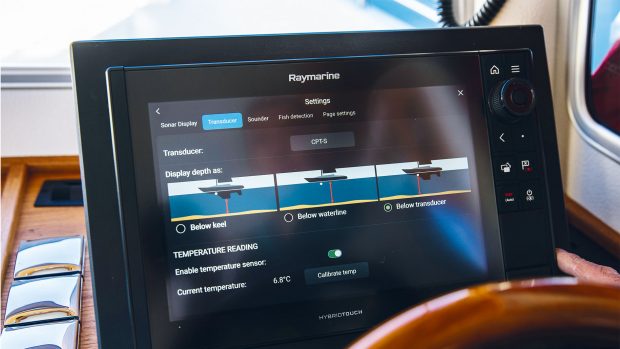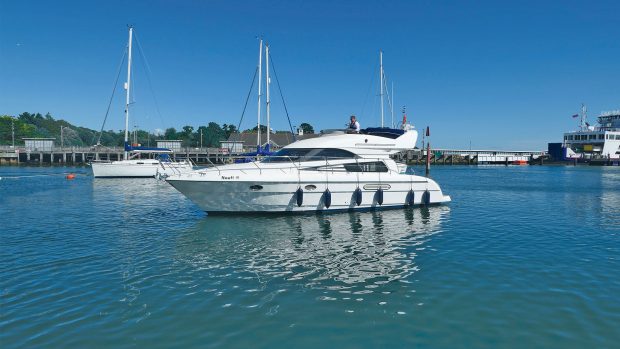Part four of Elliott Maurice’s epic Great Loop voyage sees him fulfil a childhood dream – getting up close and personal with the Statue of Liberty on approach to New York harbour.
This is part four of Elliott’s Great Loop adventure – make sure to read Part 1, Part 2 and Part 3 first.
Some people never tire of telling me that the best two days of owning a boat are the day you buy it and the day you sell it, but this is absolutely not my experience.
Some of the best days I’ve had over the past 25 years have involved lavish sunsets, beautiful beaches, wild dolphins and, of course, the satisfaction of solving the inevitable technical issues that crop up from time to time.
However, our next leg could top them all because it fulfils a bucket list item I have been dreaming of for years – running my own boat past the Statue of Liberty and into New York harbour.
I always imagined it would be on a sailing yacht, perhaps an Oyster 53 after sailing across the Atlantic. However, it will actually be on an equally iconic British motorboat, the Princess V48 I imported to Florida when I relocated here from the UK.
Waiting for the tide
We leave Norfolk, Virginia, early in the morning carrying plenty of fuel and with six of us on board bound for Zimmerman Marina located in a tiny creek, 20 miles due north up the mighty Chesapeake.

Dusk settles over a breathlessly still Chesapeake Bay
The reason for this short detour is to have a new Raymarine autopilot steering pump fitted, which is waiting for us there. My co-captain Alan has plotted a course into Mobjack Bay and down the small East River to the marina.
He is one of the best navigators I know, a qualified flying instructor and a US Marine with service on helicopters in the Vietnam conflict, so he’s confident of getting us there even though a boat of our size can only access it at high tide and then only just.
We enjoy a perfect morning run past a vast complement of warships based here at the headquarters of the US Navy and out into open waters. There must be more supercarriers, destroyers and other assorted vessels of war on show here than anywhere else in the world.
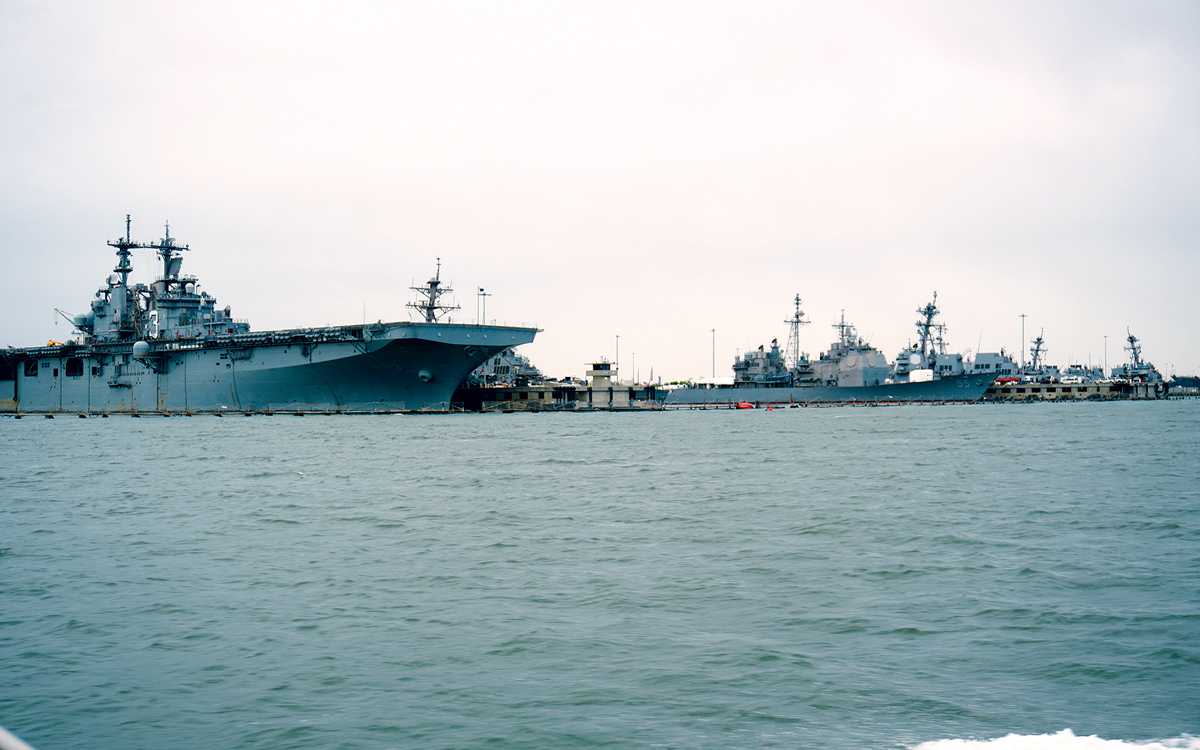
After an incident-free passage we enter the narrow river and stop some 50 yards short of the marina. There are several trawler yachts and a large Viking sportsfisher visible inside the narrow entrance. “It looks awfully shallow,” says Ronnie from the helm.
He’s not kidding; there is an obvious shallow patch between us and the marina entrance and no channel markers to help navigate it. We have clear pilotage instructions to turn from the main channel into the marina and hail on VHF channel 73.
With no response on the radio, Ronnie does not want to be the one to run us onto a mud bank and hands me the helm. The chart shows a minimum depth of 6ft so I gently turn the bow towards the entrance using one engine only and edge us forward.
Article continues below…

Great Loop: Meet the Princess V48 owner preparing for the adventure of a lifetime

Cruising the Great Loop: From Miami to Savannah in a Princess V48
Within seconds we are aground on a sticky mud bar. Shutting the engines down, I drop anchor to avoid any further movement and walk to the bow for a better look. It reveals a very sticky story.
With the tide now ebbing, things are not going to improve for several hours. After a brief telephone call, the facility manager kindly pays us a visit on a small outboard powered skiff.
“There is a small channel close to shore that is the only way in for boats your size,” he informs us. “I normally come out and pilot folks in. Besides, you are supposed to be at our other facility.”
Pondering this significant error in navigation, I ask why we were provided with the co-ordinates for this facility. “It was on the email,” comes the reply.
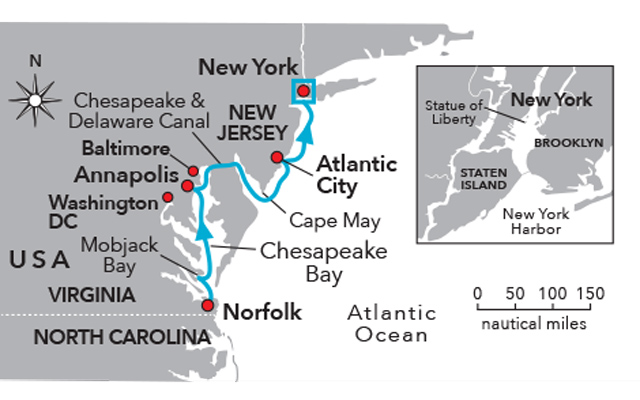
It turns out that Alan has taken the co-ordinates from the footer of the email and not the ones buried several pages further up the thread – an easy mistake to make when trying to read emails on a small phone screen. Our safest option now is to wait for the tide to come back in and float us out.
As almost all the crew are Lake Erie boaters they have never had to sit out a tide before, but I’ve spent years navigating the south coast of England so it’s not a big issue for me.
We have movies, internet and plenty of food and drink. As everyone settles in to watch a good film, I decide to launch the drone and ascertain the true nature of our predicament.
As the drone lifts skywards, a clear picture becomes visible; the stern is only 6ft away from deeper water. So, having landed the drone, I take some soundings off the stern using a boat hook.
After several pokes with the boat hook, the end of the hook sucks itself down into the sticky mud and because of my asinine position over the bathing platform, I fall gracefully into the cold water, my feet sinking deep into the aforementioned soft, sticky mud. Ah well, at least no damage can occur from our unfortunate error – other than to my pride!

Elliott takes an early bath while testing the depth of the mud
Night manoeuvres
I give up on any further attempts to get us off the mud and call Sea Tow, a fantastic subscription service that provides unlimited tows almost anywhere in the US.
This will allow us to be towed off the mud instead of trying to churn our own way out and risking any damage to the sterngear. I also use the time to plot a new route down Chesapeake and into Annapolis.
The 140 miles or so will have to be navigated through the night in darkness. Chesapeake, although wide and deep, is a very busy shipping route and not one to be negotiated without strict protocols.
Having recently installed Raymarine’s new Doppler radar and tested it well, I am confident we can handle the challenge.
With its super accurate display and AIS and proximity alarms set, I have no qualms about making the passage at night. We will take two-hour shifts, with an hour-long rotation for the person on physical watch.
I decide to name the new route “Shits Creek to Annapolis” for posterity. Sea Tow arrive in a timely manner in a small but appropriately powered, bright yellow centre console.

Sea Tow comes to the rescue
Fixing a line to the port rear quarter cleat, and with our anchor safely stowed, we are off the bank within minutes. Despite their boat’s meagre 2ft draught, even the Sea Tow crew tell us that they don’t like coming in here as the charts are never that accurate.
Politely reminding us that there is also no Sea Tow coverage in Chesapeake Bay at night, they offer to let us follow them part way to the bay entrance.
As the sun sets, the temperature immediately drops to around 10°C. One of our crew brings blankets on deck to help keep the cold at bay.
Although the mighty Chesapeake is flat calm, cloud cover shrouds any natural light from the moon or stars, and the sheer scale of the Bay means there’s no ambient light from the shore either.
After nearly two hours at the helm, taking us well out into the main channel, I call it a night and run through the intricacies of the radar set-up with the crew.
We’re using a large iPad for navigation, so we can have the radar display as large as possible on the MFD. In pitch dark, it is important that the helmsman uses the instruments only, leaving the spotter to act as his or her eyes.
With nothing to focus on, it is very easy to lose focus on course, particularly with no autopilot to help. Even one degree over 60nm will put you a mile off course and with more than 130nm to transit that would make all the difference.
I head down to a bunk to get a couple of hours’ rest. I awake about three hours later and come up on deck. In my absence we have chased down what looked like a large freighter on radar but turned out to be an aircraft carrier.
The lack of AIS signal and the fact that the giant ship was running at a cool 22 knots were the only clues to its real identity. Luckily, the crew decided to give it a wide berth as any vessel coming within half a mile of a US carrier is likely to be boarded or sunk!
By now we are only a few miles out from Annapolis and can start our run into port. Slowing to 20 knots, I begin our approach westward and at around 4am we slowly glide into Annapolis Landing.

Annapolis’s historic waterfront is a colourful reminder of a different era
In pitch black and using a spotlight to guide us in, we find our designated slip. The marina is oddly set out at acute angles and our pontoon has the narrowest dock I have ever seen.
Carefully manoeuvring the boat sideways onto the pontoon, we are soon safely tucked in for our two-night stay at the US Navy Academy’s historic home.
Annapolis calling
The following morning Zimmerman Marine’s engineer finally catches up with us, bringing our long-awaited Raymarine steering pump that should finally fix our wayward autopilot.
Unfortunately, the 6ft 5in engineer hasn’t a hope of clambering through the small gap to remove and replace the old pump. At least we now have the part and over the course of the next 1,000 or so miles should be able to find an installer who can fit!
With only a day to enjoy this pretty town, and with more friends meeting us here, we decide to take the boat across the bay to downtown Annapolis and tie up in the famous Ego Alley, a narrow canal where you can dock in front of several waterside restaurants and explore the historic place.
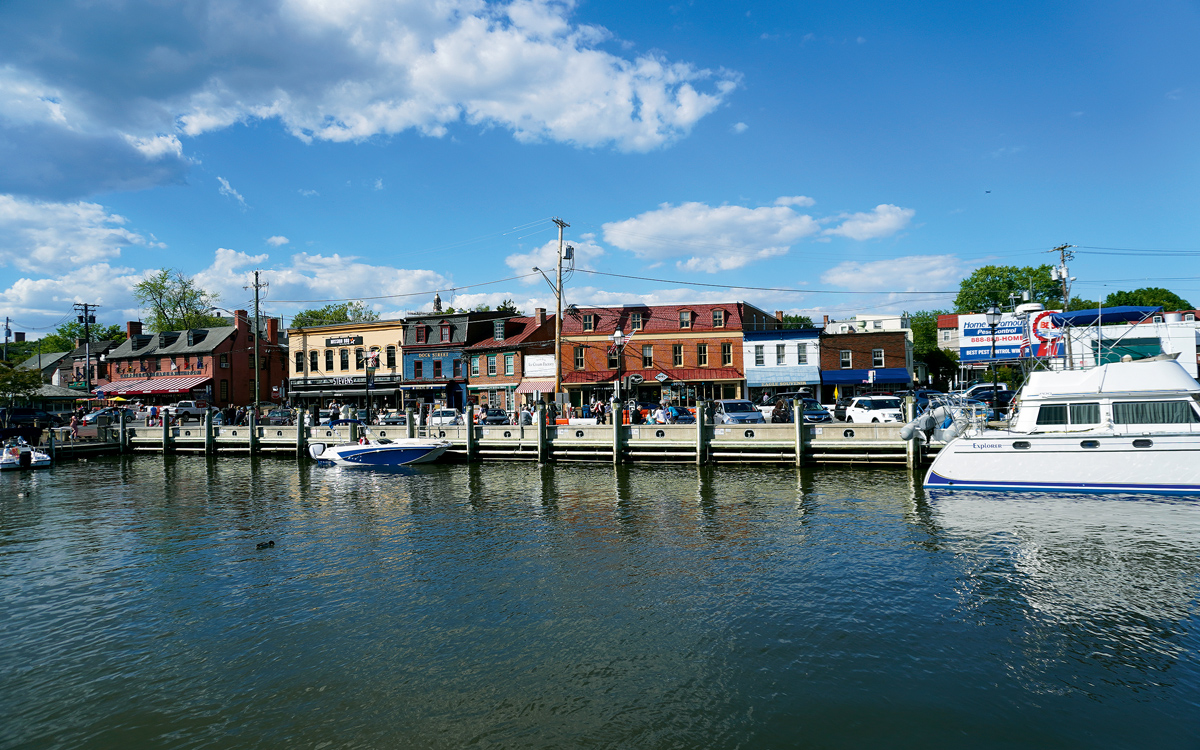
Ego Alley is so-called because it takes some bravado to manoeuvre in such close quarters and dock in full view of a throng of future Navy captains and officers. It’s a challenge we can’t resist.
We carry it off as nonchalantly as possible and tie up between a rather lovely Grand Banks Eastbay and a small centre-console sportsboat.
Annapolis is a charming place steeped in history. From 1783 to 1784 it was the temporary capital of the USA when General George Washington resigned his commission and set America on a path to becoming an independent nation.
The town is teeming with future US Navy officers, immaculately dressed in their pressed white uniforms. Its numerous Victorian taverns and restaurants offer fabulous fresh fish, crab and lobster and provide the perfect respite after our long night at sea.

Another beautiful morning in Annapolis Yacht Club’s marina
The trip out of Annapolis will take us through the famous Chesapeake and Delaware Canal, or C & D canal for short. This 14-mile man-made canal cuts across into the Delaware River, providing access to Philadelphia to the north-east and the Atlantic via Delaware Bay to the south-east.
Our route will take us past Baltimore into the canal and under the Summit Bridge to the Delaware River, then out past Cape May onto the Atlantic’s Jersey shore and on to Atlantic City for the night.

Cruising up the broad Delaware River
The C & D canal is a lovely ride and allows good progress through the scenic landscape. A lunch stop and some cheap diesel ($2.73 a gallon) at the family-owned Schaefer’s Marina proves very welcome – the courteous owner serving us some excellent crab cakes and fresh lemonade.
After a quick chat with a couple who have just purchased a rather fine 1980s Grand Banks Europa 46, we set off for Atlantic City. With 60nm until we reach the ocean, we surge up the wide Delaware River in perfect weather past the historic Whale Watchers’ Lighthouse, so called because of the frequent sightings of humpbacks at this location.
Unfortunately, we are not treated to one this time but the journey up Cape May and into the Labrador current is as perfect as any I have known. A gentle 2ft swell and almost no wind give us ideal conditions for a comfortable 28-knot run, eating up the 45nm to the Jersey shore and into Atlantic City.

Opening up the throttles on the journey north
Several friends have flown in to meet us for the ride into New York and greet us warmly on our arrival at the Senator Frank Farley Marina and Golden Nugget Casino.
It is common practice for owners to have their captains move their boats away from the potential hurricanes and oppressive heat of Florida to New York and Rhode Island for the summer, and sure enough we spot a Sunseeker Predator 74 we had seen in Miami, a Pershing 84 that had rocketed past us in Florida, a Princess S62 from Cape Fear and a 60ft Nordhavn we had moored next to in Jacksonville.
The Big Apple
Needless to say, the vista at this Las Vegas-style resort is spectacular and we tuck into a fabulous steak meal before hitting the casino for a few more games and cocktails. With a relatively late 10:00am start planned for the run up the Jersey shore and into New York, we can afford an evening of fun.
The next day starts with a safety briefing for the 108 miles of ocean ahead. Thankfully, we have perfect conditions. The sea is almost flat and Privilege is now running problem-free, lapping up the miles at a fast 28-knot cruise.
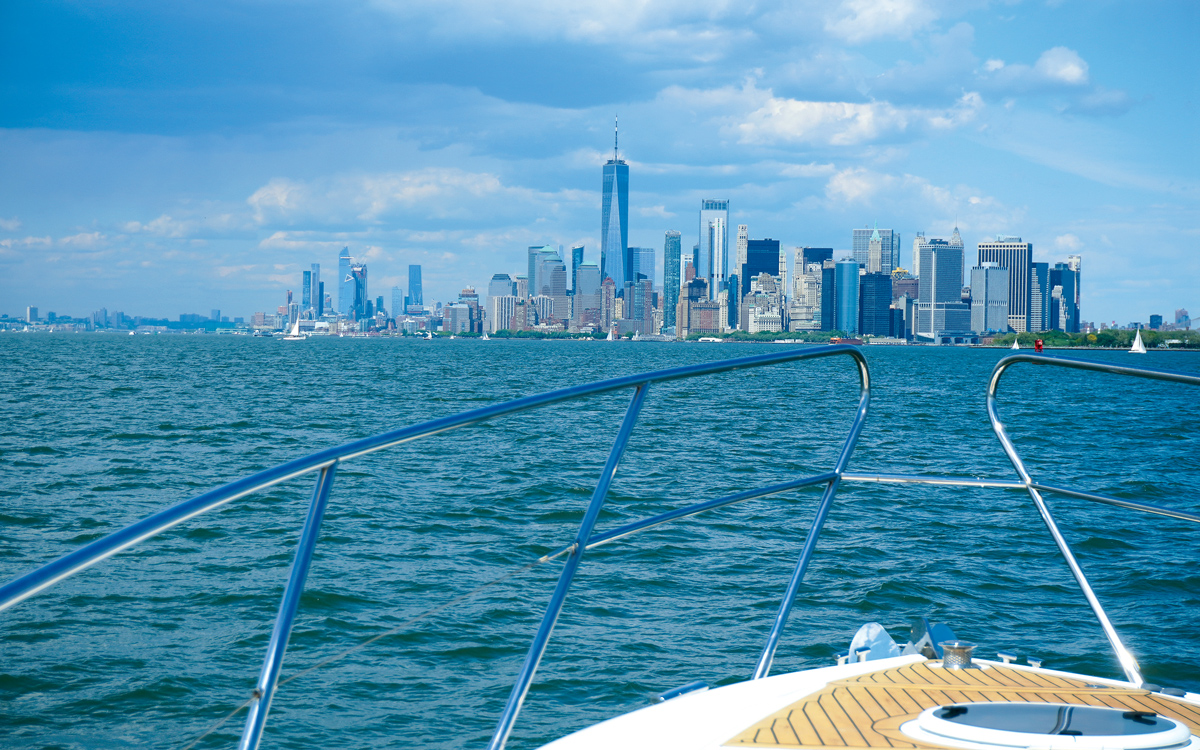
I crank up the 1980s playlist on the 3000W sound system and soak up the sunshine with my friends; this truly is one of those “best days” of owning a boat.
A course four miles offshore gives us a fabulous view of the Jersey shoreline, and after three hours of effortless passage-making the spectacular New York skyline comes into view.
New York harbour is the largest in the US and as well as being notoriously busy has a very significant security presence post 9/11.
None of this detracts from the magnificent skyline. The entrance to New York harbour is vast and framed by the mile-long Verrazzano-Narrows Bridge linking Staten Island to Brooklyn. Passing under it is a momentous experience.
A further 6 miles and just east of Jersey City lies the iconic Statue of Liberty. The best seats in the house are only available on a private boat, and we are able to pull up to within 100m of Liberty Island and revel in the full majesty of this 300ft-high symbol of independence and freedom.

The realisation of Elliott’s dream to enter New York on his own boat
Its mantra – “We hold these truths to be self-evident, that all men are created equal, that they are endowed by their creator with certain unalienable rights, that among these are life, liberty and the pursuit of happiness” – has never felt more pertinent.
This is what I have cruised nearly 1,700nm to see and it will unquestionably stay in my mind as one of the best days of my life.
After taking our obligatory photos on the bow, we make our way towards the exclusive Liberty Landing Marina. But first we swing into Surf City, a fun waterside area where we squeeze Privilege between some smaller boats for a celebratory cocktail with friends and family native to New York.

Safely docked in Liberty Landing Marina
The next three days will be spent visiting the city’s monuments, eating at its fabulous restaurants and treating Privilege to a serious clean up.
The next part of our trip will see us making our way inland along 600nm of the oldest trade routes in America at a far more sedate pace, albeit with plenty of different challenges to face.
Next month: Elliott takes on the mighty Hudson River and the historic Erie Canal en route to the Great Lakes.
First published in the November 2021 issue of MBY.
If you enjoyed this…
Be first to all the latest boats, gadgets, cruising ideas, buying advice and readers’ adventures with a subscription to Motor Boat & Yachting. Available in both print and digital formats, our monthly magazine will be sent directly to your home or device at a substantial discount to the usual cover price. See our latest offers and save at least 30% off the cover price.






